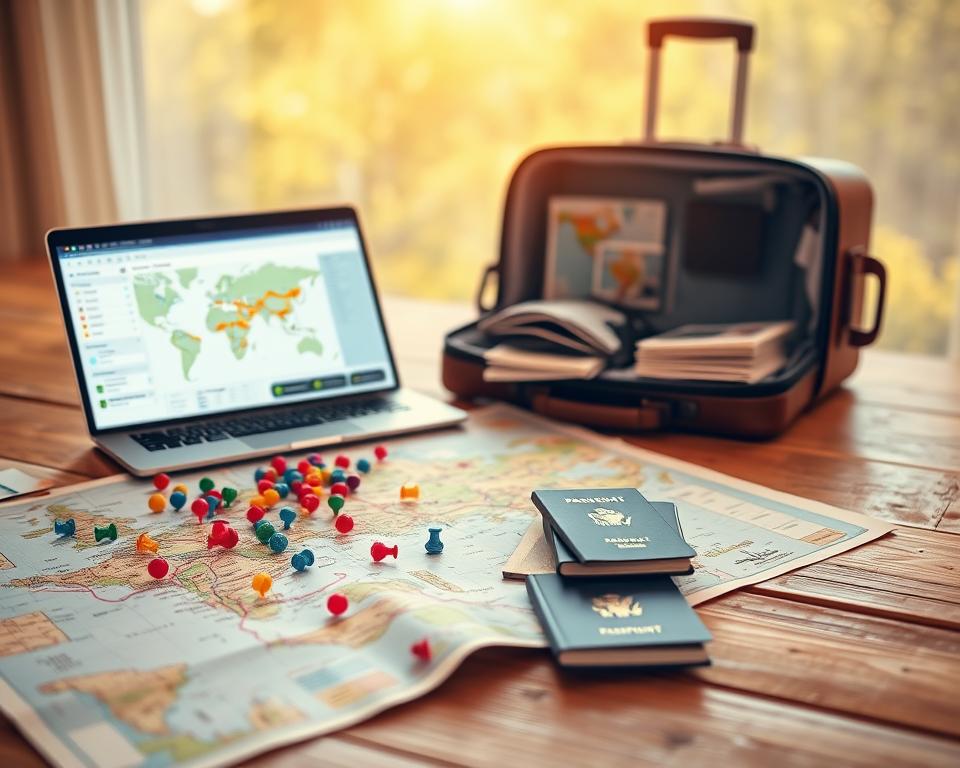Anúncios
Travel Design trends 2025 asks a simple but sharp question: can a room make your trip feel more meaningful? You will find this guide timely because the hospitality world is shifting toward sustainability, smart rooms, and cultural authenticity.
The shift matters now because younger, values-driven travelers prefer substance over flash. Hotels from Dubai to New York mix eco materials, AI comfort settings, and local storytelling to shape how you rest and dine. These choices change your comfort, your time on property, and your loyalty to brands.
This short guide gives you a practical map of the new landscape and clear steps you can use when you book. Verify entry rules and local advisories with official sources, plan responsibly, and remember that every experience is personal and unique.
Why Travel Design matters in 2025: shifting travelers, smarter spaces, better experiences
Guests now expect rooms that reflect purpose and personal taste, not just grand finishes. You notice this in booking choices, reviews, and what people share on social feeds.
From opulence to meaning: Luxury is shifting toward personalization and purpose. PwC finds 65% of customers value personalization and many will pay up to 25% more for tailored stays. Virgin Hotels’ “The Know” shows how recognition beats generic rewards.
Anúncios
Design’s bottom-line impact on guest experience and loyalty
Well-planned spaces shape mood right away. Lighting, texture, and flow set expectations and raise perceived value.
The 2025 context: sustainability, tech, and a stronger sense of place
Hotels use AI rooms, sustainable materials, and biophilic cues to meet new needs. McKinsey notes many “aspiring luxury” guests are under 60, so the industry adapts to diverse budgets and younger generations.
- Personalization matters: data used well creates loyalty without intruding.
- Sustainability counts: energy efficiency and local materials influence your choices.
- Sense of place: cultural immersion often matters more than showy finishes.
The core pillars shaping luxury hospitality design today
Luxury now reads as stewardship—how a hotel supports its environment and guests. Below are the practical pillars that shape guest experiences and choices today.
Anúncios
Sustainability and regenerative practice
Look for materials and systems that verify impact. Reclaimed wood, recycled metals, and organic textiles reduce footprint and add warmth. Water- and energy-saving systems matter for comfort and cost.
Smart rooms and AI-assisted comfort
Your room should learn fast. AI controls adjust lighting, temperature, and even artwork to your routine. That means fewer taps and better rest.
Authentic storytelling and local craft
Indigenous art, local materials, and menus tied to place create a stronger sense of place. This connection makes stays feel meaningful and respectful.
Flexible spaces and wellness by design
Modular furniture shifts a suite from work to social moments. Biophilic elements, good light, and quiet acoustics lower stress and improve sleep.
- Verify materials and systems for true sustainability.
- Let AI handle routine comfort so you focus on the stay.
- Choose hotels that tell local stories through craft and cuisine.
- Prefer spaces that adapt for work, wellness, and socializing.
Real-world examples: Six Senses and Soneva lead regenerative practice; Dubai properties pair futuristic tech with sustainability; New York boutiques use minimalism and art for high impact in small footprints.
Personalization, loyalty, and the data advantage in travel hospitality
Personal data, used well, turns a standard stay into a smooth, tailored rhythm that saves you time. The best programs use AI and micro-segmentation to match small choices to your profile so you arrive to a room that feels familiar.
Hyper-individualization with AI
AI learns fast. It adapts lighting, sleep settings, and minibar items in real time. This reduces friction and makes your stay more efficient.
Loyalty as recognition
Look for programs that reward recognition over points. Virgin Hotels’ “The Know” shows how curated amenities, pillow choices, and targeted upgrades build attachment beyond perks.
Designing for preferences
Hotels can pre-set room layout, lighting warmth, and allergy-friendly mini-bars from your history. Ask brands to sync profiles across properties so your preferences travel with you.
What travelers will pay more for
Use PwC’s insight: 65% value personalization and many will pay up to 25% more for tailored stays. Expect clarity on data use and opt-ins—consent keeps personal service respectful and safe.
- You benefit when data removes routine choices like pillows or minibar items.
- Choose programs that prioritize recognition and meaningful upgrades.
- Ask for clear consent and simple controls over your profile.
Experiences with a sense of place: culture-forward travel and quiet luxury
A deep sense of place makes a stay feel less like a stay and more like a story. You get a richer visit when local craft, food, and history shape the rooms and programs.
Immersion that feels real: Book hotels that partner with local chefs for private market tours, cooking classes, and farm-to-table dinners. Seek artisan-led workshops—pottery, weaving, scent labs—to meet makers and learn techniques.
Legacy revived: Properties such as Hotel del Coronado and the Omni Homestead show how layered history and modern comfort create narrative-rich interiors. WATG/Wimberly note that these restorations bring theatrical storytelling into hospitality.
Community-led nature and quiet luxury
Choose guided conservation walks and wellness outings run by local experts. This pairs comfort with purpose and helps communities benefit from tourism.
- Book after-hours museum access or heritage tours with indigenous guides.
- Favor properties that invest in local craft and regenerative practices.
- Look for low-profile exclusivity—privacy, craft materials, and quiet service.
“Eighty-one percent of travelers want cultural immersion,”
For a wider view of how quiet, reflective stays are shaping the industry, see the silent travel report. Choose destinations and hotels that match your preferences and help responsible tourism grow.
Business models and technology trends shaping travel brands in 2025
Subscriptions, smart bundles, and immersive previews are changing how you plan trips. These shifts let you trade single bookings for programs that favor predictability and choice.
Membership and subscription travel: Companies like Inspirato now report annual subscription revenue above $75 million, showing the market for steady access. You can consider a membership if you value open inventory, preferred rates, and simpler booking for frequent trips.
Dynamic packaging and collaborative ecosystems
Dynamic packaging bundles flights, hotels, and activities so you can mix items to match budget and schedule. Cross-industry collaborations—chefs, designers, and wellness experts—add multi-sensory value that turns a stay into an experience.
VR/AR previews and data-driven personalization
VR and AR let you preview rooms and layouts before you book, reducing decision friction and boosting confidence. Meanwhile, real-time data personalization speeds routine choices while demanding clear consent and easy opt-outs.
- Consider memberships when predictability and perks matter to you.
- Use dynamic packages to tailor trips without juggling separate bookings.
- Try VR/AR previews to see spaces and reduce surprises.
- Expect transparent data practices that keep profiles portable across brands.
“Markets reward brands that offer flexibility and simple service promises.”
Travel Design trends 2025: practical steps for travelers and brands
Small choices before you book can steer a stay toward meaning, comfort, and fewer surprises.
For travelers: pick clear commitments
Shortlist destinations and hotels that show eco-certifications, local sourcing, and cultural partnerships on their sites or reports.
You’ll get richer travel experiences by booking properties that employ local artisans and offer community-led tours with transparent impact data.

- Choose refundable rates or memberships for more flexibility on family trips.
- Share your preferences—sleep, wellness, food—before arrival so teams can tailor service.
- Check tourism boards and embassy sites for entry rules and add buffer time to trips.
For brands: adapt, personalize, and show impact
Design adaptive, tech-enabled spaces that support quiet work zones, natural light, and ergonomic setups for guests on the move.
Measure and publish local sourcing and conservation outcomes so travelers see real value beyond flash.
“Eighty-one percent of travelers want cultural immersion.”
Conclusion
Small, thoughtful choices now steer stays toward meaning, comfort, and lasting value. You’re entering a market where sustainability, smart tech, and cultural storytelling shape what luxury means today.
Prioritize the preferences that matter to you—sleep, light, culture, and clear service—so hotels focus on what improves your stay. Use data as a tool you control and ask for transparency when sharing profiles.
Expect modest upgrades to boost comfort more than flashy add-ons. Plan responsibly: check official tourism and embassy advisories and keep flexibility for family or schedule changes.
Take these insights as guidance, not guarantees. Choose destinations and brands that honor people and place, and you’ll help the hospitality industry build a thoughtful, resilient landscape for future travelers.



